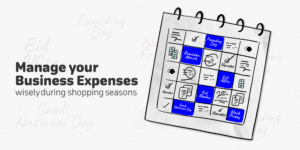In 2022, the demand for contactless, online, digital, and speedier payments have only increased, especially since the pandemic pushed for more innovation in the industry. For fintech solutions, such as digital payments and buy now-pay later (BNPL), this pushed for offering new ways to make payments as they continue to attract billions in investments globally, aimed at creating faster, easier, and cheaper worldwide payment tools.

“faster, easier, and cheaper” is the motto for payment technology
While the market seems to respond well to consumers’ shift in their buying behavior and cater to the demand for better solutions, not the same can be said about small and medium businesses -or SMEs-. Once new fintech companies capture the potential the SMB market has and the various needs that are not yet optimally met, we will see new competitive solutions to make the financial operations in SMEs much more seamless.
In Saudi Arabia, the number of small and medium enterprises (SMEs) increased by about 68%, reaching 752,500 during Q1 of 2022, in light of the incentives provided by Vision 2030. This in itself should be seen as a driving factor for fintech companies who aim at diversifying their kit of solutions and reaching a market that is in dire need of attention.
With that in mind, here we mention three trends in payments that are of concern to SMEs
Embedded Finance can better serve small-business users
To better support their small and medium-sized business users, platforms are turning to embedded payments (as well as other financial services, like enhanced pay-out options/flexibility, card issuing, capital/lending, and foreign exchange). By doing this, they can increase revenues, improve cash flows, and develop more appealing products.
As a result, platforms and financial institutions are under pressure to do more to combat financial crime and uphold oversight requirements. Although the compliance technology sector is growing, it is a dispersed one. In the years to come, Fintech platforms will require a comprehensive strategy for payments and compliance services.
B2B businesses need a different set of features
The market has become crowded as BNPL, which enables customers to stretch payments over a certain length of time, continues to gain popularity. BNPL players such as Affirm and Klarna are competing with digital payments giant PayPal, card issuers, and large and mid-tier banks.
Once BNPL providers have built a relationship with customers, it is anticipated that they will expand their service offerings to include loans, brokerage accounts, and cryptocurrency. Some significant BNPL businesses, including Klarna, have already debuted new products like debit and rewards schemes.
The financing model might also be used to attract businesses. On the consumer side, it has expanded, but it is still uncommon when it comes to companies. This switch from consumer purchases to business contracts may have major implications for other market participants. Why? Mainly because a larger sum of money will be transferred from the card networks to the loans.
Still, when customers fall behind on payments, BNPL practices can potentially come under more regulatory scrutiny. Mizuho Americas analysts point to delinquencies and charge-offs rising across BNPL operators, and the frequency of consumers missing payments or borrowing through multiple apps.
Retailers and payment networks are navigating the recent e-commerce boom
Amid the rise in e-commerce, payment networks and retailers need to find common ground when it comes to fees. We saw disputes erupting around this area, as both sides look to adapt to the new digital marketplace. Leading firms are going to set the trend as they address the boom in e-commerce transactions in the future.
Visa and its rivals Mastercard, American Express, and Discover Financial, are dependent on swipe fees. The Nilson Report estimates that overall U.S. swipe fees increased by 70% over the previous ten years, from $64.6 billion in 2010 to $110.3 billion in 2020.
How new trends in Fintech are going to drive these numbers in the future? Only time will tell
While we tend to view the recent developments in the e-commerce and payments sector from the customer’s angle, we might be missing the full picture. SMEs can grow faster when they are given the right tools, especially for managing their finances, since many of them do not hire permanently and operate with small teams. If you own a small business or growing your startup, keep updates on the market in mind and discover what is there on offer, you might be surprised by the fintech solution already available.





